Minor roads three miles south of Montrose lead you to Boddin Point, a spur of rock projecting south east at the northern end of Lunan Bay.
| ||||||||||
Between Boddin Point and the line of the main railway to Aberdeen lies the hamlet of Boddin, now no more than a few farmsteads and a bothy. Limited parking is usually possible on the verge above the gated track leading down to the point itself: remember that farm vehicles use the roads and gates around here, so don't block either.
Why come to Boddin Point? It isn't to everyone's taste but if you like exploring rocky shorelines and rockpools or just enjoying wild coastal scenery with a sense of history and great views, then this is a superb spot.
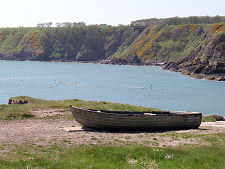 View South from Boddin Point | |
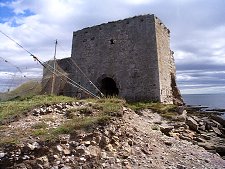 The Limekiln in 1996 | |
 ...and in 2003 |
The maps show a harbour here, and on the sheltered western side of the point a concrete slipway leads down to the shore. A few boats pulled up onto the neck of Boddin Point amid drying nets and lobster pots shows some continuing activity. The shoreline beyond the slipway and along the coast to the inlet of Black Jack are said to be a good hunting ground for agates.
Two words of warning: this would be a bad place to be caught by an incoming tide, and signs of fresh erosion suggest that standing too close to the base of the cliffs without a hard hat (or at all) might not be a good idea.
The most prominent feature on Boddin Point itself is the limekiln standing at its seaward end. This dates back to the 1700s. Parts of the kiln have been in a state of collapse for many years. A visit in 2003 showed that undercutting by the sea on that side of the headland was getting worse, and we were surprised to find it still standing in 2008. But it really isn't clear what is holding up much of the structure, and it may not be there for very much longer
A track leads round to the top of the limekiln. Here you get great views south along Lunan Bay and out to the Bell Rock Lighthouse, but while admiring them remember that the south side of the kiln really could end up in the sea at any moment.
To the north east of Boddin Point the coast continues round past the ruins of a salmon fishing station built in the 1800s. A little further on you find Elephant Rock, a natural coastal arch that has been shaped by the sea into a resemblance of an elephant.
Close by is a clifftop cemetery. Here you can find the grave of one George James Ramsay. Not a well known man: but one who, according to his gravestone, was born on 24 November 1859, nineteen years after his death on 17 December 1840.

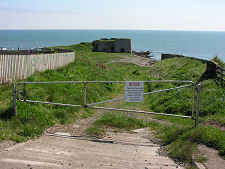
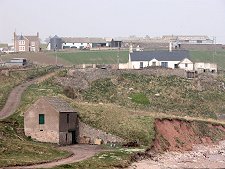
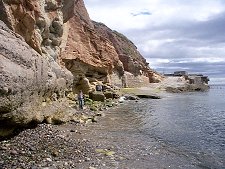
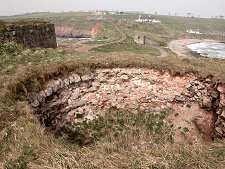
No comments:
Post a Comment